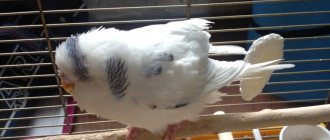The hamster's face is especially attractive and charming due to its small, slightly convex beady eyes. Physiological exophthalmos is the name given to the natural protuberance of the eyeballs in hamsters, which gives these rodents the ability to quickly navigate in space and notice danger in the form of predators. However, it happens that one or both eyes become too bulging, and this may indicate a disease.
You need to constantly monitor your hamster to understand if he is unwell
The hamster's eye has bulged out - what could be the reason?
You can tell if your hamster is unwell by watching him. The following signs indicate that an animal is sick:
- Refuses food and water;
- The rodent's fur becomes disheveled and unkempt;
- The animal generally behaves sluggishly and inactively;
- He loses weight very quickly.
You can tell that something wrong is happening with your little pet’s eyes using the following markers:
- Inflammatory process: redness, swelling.
- The appearance of pus;
- Inflamed eyelids close poorly;
- One or both eyes protrude unnaturally compared to the other.
Cloudy discharge indicates an infectious cause of inflammation, and clear discharge indicates an allergic reaction.
What are the reasons why hamsters' eyes fall out? There is only one reason: inflammation, but there can be several ways inflammation can occur. Globally: either due to injury or as a result of advanced disease.
Has your hamster been injured before?
As for mechanical injuries, it is quite easy to damage an animal’s eyes. An unsuccessful fall, the ingress of small particles of hay, feed, coarse dust particles - all this can damage the mucous membranes, cause suppuration and, as a result, loss.
Symptoms of bruise:
- Redness;
- Disorientation due to loss of vision;
- Nervousness of the animal.
Among the eye diseases that can lead to illness are:
- Advanced form of conjunctivitis;
- Glaucoma;
- Tumor.
IMPORTANT! Eye loss in a hamster is the last stage of the course of ophthalmological diseases.
At the initial stage, the eyes simply water.
With conjunctivitis, first one organ is affected, then another. The disease can be caused by small solid particles entering the mucous membranes. They are the ones who “trigger” the proliferation of bacteria and the pathological process. At the initial stage of the disease, the eyes may simply water, then cloudy discharge appears. They transform into pus over time. Constant inflammation leads to enlargement and prolapse of the eye socket.
Conjunctivitis can be recognized by symptoms:
1) Inflammation, swelling of the eyelids;
2) The appearance of purulent discharge in the corners, then throughout the entire eyelid;
3) Decreased appetite, general lethargy;
4) “Swimming”, the eyelids become narrow and stick together from pus.
This disease can be either infectious or allergic. In advanced forms of conjunctivitis, the inflammation progresses so much that the eyelids, on the contrary, are difficult to close, which leads to loss.
Glaucoma is a hereditary disease in which intraocular pressure increases. Not all hamsters suffer from this disease, only Campbell's.
Symptoms of glaucoma in hamsters:
- Increased intraocular pressure;
- Enlargement of the eyeball.
Without treatment, the eyeball bursts and leaks. Painful shock and repeated inflammation quickly lead to the death of the rodent.
Hamsters, unfortunately, are susceptible to cancer. When lumps or growths appear on the eyelid or close to the eye, it may indicate the formation of a tumor. As the tumor grows, it puts pressure on the eye and leads to eye loss.
You should consult a doctor immediately
How to identify eye diseases
Healthy pet eyes look bright and clean, without redness. There should be no discharge or crusting, swelling or sticking of the eyelids.
Important! Some breeds of hamsters initially have reddish eyes, so you need to observe how healthy they normally appear to watch for signs of injury or infection.
Hamsters are very often exposed to diseases and damage to the eyes, since the latter are on the protruding side and easily become dirty, poorly moisturized due to a reduced blink reflex.
Symptoms of eye diseases may include:
- redness of the edge of the eyelids;
- intense blinking;
- increased photosensitivity;
- itching and swelling;
- purulent discharge;
- active lacrimation or dryness;
- the appearance of a cloudy spot on the cornea;
- sticky eyelids;
- the eye is red, cloudy, swollen, hot to the touch;
- the eyeball bulges or falls out;
- pain when touched in the area of inflammation.
It is quite easy for a hamster to develop an eye infection, and it occurs in both old and young hamsters.
The reasons for this are numerous:
- allergies to bedding, especially if pine, cedar or other aromatic materials are used;
- dirty litter (cleaning must be done once a week);
- random bacteria on your hamster's food, such as a piece of apple or broccoli;
- infection from scratching the eyes while grooming;
- cold caused by draft;
- inflammation of the cheek pouch;
- low immunity and age-related changes;
- ingrown teeth (need to be trimmed every 2 weeks) begin to put pressure on the cheek and irritate the eyes.
Ocular bacterial infections are extremely dangerous for rodents. In case of damage and in the absence of prompt intervention, irreversible changes can occur, which can lead to deterioration and loss of vision and metastasis to the brain. The eyes may fall out, bulge out of their sockets, and leak.
Important! The sooner you contact a veterinary clinic, the greater the chance of saving the eyeball and preserving your pet’s vision.
What to do if your hamster's eye pops out?
If the hamster's eye has already popped out, then nothing can be done at home. Attempts to straighten or tuck the eye back will bring even more pain and stress to the animal. You should urgently contact a veterinarian , preferably a highly specialized veterinarian: a veterinarian or an ophthalmologist. A qualified doctor can accurately determine the cause of eye loss and take appropriate action.
REFERENCE! Veterinarians who specialize in the treatment of chinchillas, rats, hamsters and other rodents are called ratologists.
At home, you can help only in the early stages, and then, for the most part, by following preventive measures.
If it is conjunctivitis, then in the early stages appropriate treatment is prescribed: removal of purulent discharge using sterile cotton swabs soaked in saline solution or an aqueous solution of furatsilin. Any product applied to a cotton swab for subsequent processing should be slightly warmer or at room temperature. Treatment is carried out 3-4 times a day until visible improvements occur. If improvements do not occur within 2-3 days, then add drops containing antibiotics, such as Floxal, Tobrix, 1 cable up to 6 times a day for 5 days.
It is important to remember that open eye drops have a very short shelf life. Expired medicine should not be used.
Sometimes doctors prescribe systemic antibiotics, such as Baytril. However, they do not make much sense for treatment, since the eyeball is not permeable to antibiotics. But an ointment with an antibiotic inside, for example Floxal, can have a positive effect.
You cannot take long breaks in treatments, so your pet will have to wipe its eyes at night. Otherwise, in the morning the animal’s eyelids will constantly be stuck together from pus.
Ignoring treatment of conjunctivitis leads to the development of panophthalmitis, a disease in which protrusion occurs. At this stage, no treatment will help; only surgical removal is indicated.
For glaucoma, therapeutic treatment is impossible. Only surgical intervention through removal of the organ of vision is indicated. If no action is taken, the eye may burst, leak, and the animal will die from painful shock.
REFERENCE! There is also no treatment for cancerous tumors other than removal of the eye.
We emphasize that, unfortunately, if the eye has already fallen out, then in the clinic in 90% of cases the doctor will suggest removing the eye in order to save the animal’s life. The operation on small rodents is quite difficult and the hamster may die right in the hands of the surgeon, but such a procedure will at least give the animal a chance to survive.
Avoid spraying chemicals near the hamster cage
Why is conjunctivitis dangerous?
Conjunctivitis for hamsters is not at all the same as for humans. If a person can cope with this problem in a few days with the help of eye drops, then your pet does not have the opportunity to overcome the disease on its own. For this reason, you need to be wary if you notice at least one of the signs of conjunctivitis. It is worth considering that conjunctivitis, as a rule, is the very beginning of the pathology. Without taking appropriate measures, conjunctivitis will quickly turn into keratitis, followed by ulceration of the cornea of the eye. If a hamster's eye is swollen, but the owner does not pay any attention to it for a long time, then the rodent may go blind and then die.
The same dangers await the pets of their owners, who not only do not pay attention to the problem, but treat the pet incorrectly.
Under no circumstances should you self-prescribe pills to your pet or, even worse, give injections. This should only be done by an experienced veterinarian.
If you prevent your hamster from getting sick or detect it in time, you won’t have to think about why your hamster’s eye popped out and how to help him in such a situation. Often, due to late detection of the disease, pets completely lose their vision.
Preventive measures
To reduce the risk of diseases that can lead to eye loss, preventive measures should be taken in a timely manner. These include:
- Regular cleaning of the bedding in the hamster's cage;
- Avoid free walks around the apartment without a special ball so that the animal does not hurt itself on sharp corners or falls from a height.
- Avoid spraying chemicals or aerosols near the hamster's cage;
- Regular cleaning of dust near the animal’s cage;
- Balanced feeding and timely hygiene procedures;
- Regular examination of the animal and timely contact a veterinarian at the first signs of illness.
Treatment for droopy eyes
If an animal's eyes are stuck together, you should not try to forcefully separate the eyelids - this will lead to injury. In this case, rinsing is carried out, but the crusts are generously moistened with a medicinal agent. After this, they soften and become easier to remove.
To eliminate eye stickiness, you should clean your eyelids with saline solution.
Symptoms of vasculitis in a child
There are dozens of vasculitis - each of them affects one or another type of vessel and is accompanied by specific symptoms. They appear when damaged:
- skin - spotty hemorrhages;
- nerves - partial or complete loss of sensitivity;
- joints - joint pain;
- visceral vessels – abdominal pain;
- kidney – glomerulonephritis;
- brain - strokes.
General symptoms:
- weakness and increased fatigue,
- temperature increase,
- loss of appetite,
- pallor.
The most common vasculitis:
- hemorrhagic,
- allergic,
- urticarial,
- Wegener's granulomatosis,
- Kawasaki disease.
Hemorrhagic vasculitis is manifested by a palpable hemorrhagic skin rash, pain in the ankle and knee joints, sometimes in smaller ones. Cramping abdominal pain lasting from 3 to 10 days is not uncommon, and its clinical manifestations are similar to appendicitis, ulcer perforation and intestinal obstruction. Sometimes they are accompanied by nausea and vomiting, blood in the vomit and stool, and kidney damage - homerulonephritis. The diameter of the rash is 1-3 mm. The rash is symmetrical and initially appears on the legs and feet. Erythema and areas of necrosis are possible. Source: E.V. Borisova Hemorrhagic vasculitis in children // Pediatrics, No. 6, 2004, pp. 51-56
Symptoms of allergic vasculitis:
- erythematous and hemorrhagic spots and nodules;
- hemorrhages under the toenails;
- itching and pain in the rash area;
- necrosis – necrosis and blackening of the skin in the area of the rash;
- pain in muscles and joints.
The disease affects the lower extremities, and in generalized forms it also affects the trunk and forearms. In Behcet's disease, the mucous membranes of the mouth and eyes are affected, ulcers and erosions form.
With urticarial vasuclititis, dense blisters appear. Fever and muscle weakness, joint pain and kidney failure may occur. Diarrhea, conjunctivitis, laryngeal edema, increased intracranial pressure and cardiac arrhythmias are common.
Wegener's granulomatosis is manifested by damage to the kidneys and lungs, laryngeal stenosis, and nodular rashes on the skin.
Kawasaki syndrome - damage to the blood vessels of the heart, respiratory tract and lymph nodes. It begins rapidly with an increase in temperature to 38-41 oC. Other symptoms:
- debilitating fever;
- a rash with plaques that resembles scarlet fever;
- damage to the eyes and respiratory system;
- thickening and redness of the skin on the palms and soles;
- enlarged cervical lymph nodes;
- redness of the tongue;
- peeling of the skin of the fingers;
- aneurysm and heart pain. Source: I.Ya. Lutfullin Kawasaki syndrome: clinical algorithms and the problem of underdiagnosis of the disease // Bulletin of modern clinical medicine, 2021, vol. 9, issue 2, 52-60
Boring monochrome or how hamsters see the world
The vision of rodents of different breeds may differ only in the radius of coverage, but its quality remains the same for all. For example, the size of the eyes of a Syrian hamster is slightly larger than that of a Djungarian, so the field of vision will be slightly wider with a similar perception of colors and the sharpness of distinguished objects.
Hamsters are myopic animals, which does not allow them to see a clear picture of the world even at a distance of one meter.
The world through the eyes of a hamster is a blurry outline of objects or moving bodies, among which the animal can only perceive their contours and two shades - yellow and green.
Despite the apparent paucity of vision, rodents are well adapted to survival. This quality of perception is the best option for them, comfortable for a safe existence.
This feature is associated with the way of life of the animals, which are born in pitch darkness - an underground burrow, and spend most of their time in it. Sunlight causes acute discomfort to hamsters. They begin to squint, always trying to avoid direct contact with the source of irritation.
Bacterial and viral diseases of the hamster
Hamsters are very susceptible to diseases caused by pathogenic microorganisms, viruses, and bacteria. Infection is possible by contact, aerogenous, nutritional means, or by eating low-quality feed. Some diseases of bacterial etiology can be transmitted to hamsters from humans and other pets.
Colibacillosis
The infection is caused by Escherichia coli, which parasitizes the gastrointestinal tract of animals. This disease of dzhungarik is also known as “wet tail”, as the sore is manifested by severe diarrhea.
Other symptoms of colibacillosis include:
- decreased, lack of appetite;
- weight loss;
- restless behavior;
- depression, lethargy, apathy;
- drowsiness;
- the presence of wet fur near the anus.
Hamster stool with diarrhea has a watery consistency. The hamster constantly curls up into a ball, hides in secluded places in the cage, and looks untidy.
The disease is characterized by an aggressive course and spreads very quickly, therefore, when keeping several animals together in a cage, you must immediately move the sick pet to another home. The disease can be cured only in the early stages of development.
Diplococcosis
An infection of the respiratory tract caused by round microscopic bacteria called diplococci. The main symptoms are lethargy, apathy, decreased activity, discharge from the nose and eyes. If the infection is severe, the dzhungarik refuses food and treats.
The disease requires immediate treatment using special serums. If therapy is not started, the pet’s death occurs on the second or third day.
Salmonellosis
The disease is caused by pathogenic rod-shaped microorganisms - salmonella. With this infection, hamsters experience foamy diarrhea, weakness, apathy, and pale mucous membranes.
A sick hamster refuses food, hides in a dark corner, sits motionless, showing no interest in the world around it. The rodent's tummy is enlarged.
In the stool you may notice bloody clots, threads, particles of undigested food, and mucus.
Viral pneumonia
The disease develops against the background of weakened resistance and weakened immune potential. Prolonged hypothermia, chronic otitis, hypo-, avitaminosis can also cause the development of viral pneumonia in animals.
The disease is manifested by abundant mucous, mucopurulent discharge from the eyes, nose, refusal to feed, coughing attacks, and shortness of breath. The hamster has a wet muzzle, hoarse, rapid breathing, and pale mucous membranes. If he shakes his head, his ear, wax has accumulated in the ears, there are crusts and an unpleasant odor emanates, most likely the animal is sick with otitis media, the cause of which is a respiratory illness.
Pneumonia develops against the background of ophthalmological diseases or can provoke eye and ear diseases. With timely treatment, the hamster recovers completely within a week.
Aujeszky's disease
Pseudorabies is a deadly viral disease. The disease manifests itself as severe nervous disorders. The hamster becomes restless and may show aggression. Attacks of excitement are replaced by complete apathy. A sick pet has poor coordination of movements. Muscle spasms and cramps are noted. Death occurs due to paralysis and severe exhaustion. Treatment is carried out with special serums.
Lymphocytic choriomeningitis
One of the viral infections that poses a danger to humans. May be latent (asymptomatic). The main signs are sudden weight loss, decreased activity, refusal to feed, frequent bowel movements, and urination. Most often, the virus is transmitted from a hamster to newborn hamsters. In pregnant females, the disease provokes spontaneous miscarriages.
The infection is incurable, so if your pet is infected, it will unfortunately have to be euthanized.
Anatomy of the Djungarian hamster
The structure of the Djungarian hamster does not differ much from the anatomy of the Syrian. Only some differences between these two types of hamsters are related to the size of the skeleton and the characteristics of the hairline: for example, the size of the Djungarian hamster can reach only 10 cm, and the Syrian hamster can be twice as large.
The next difference is related to the presence of hair on the feet of the Djungarian hamster. This feature in zoology has its own term - hairy legs. The Djungarian hamster is also distinguished by the presence of a gray stripe that runs along the back from head to tail.
The gestation period for both types of hamsters is also different - a female Syrian hamster is able to bear a fetus in 15-17 days, while a female Djungarian hamster can bear a fetus in 20-22 days. Both types of hamster are capable of conceiving new babies within a day after birth.
As for the structure and location of the ears, in both types of hamsters they are located on the temporal part.
The ears of hamsters are not only an organ of hearing, but also of coordination and orientation in space.
The hamster's limbs are four legs, with the front legs being more developed than the hind legs. There are four toes on the front paws (as well as a fifth, atrophied and smaller one), and five full toes on the hind paws.
The hamster's front legs are designed for digging holes and shelters, and the back legs are for throwing the dug earth back.
Like any other rodent, the hamster has a tail, the size of which varies from 7 millimeters to 7-10 centimeters. Its main task is to protect the anus from the penetration of bacteria and all kinds of infections.
Basic average statistical data of the Djungarian hamster:
- Weight. The female weighs between 80 and 150 grams, while the male weighs between 100 and 150 grams.
- The body length depends on the sex of the rodent and can reach 19 centimeters.
- The body temperature of a healthy animal ranges on average from 36.8 to 38 degrees.
- A hamster's breathing, depending on its condition, can vary from 35 to 140 chest movements per minute.
- The hamster's pulse depends on its content and the degree of mental arousal and can range from 210 to 500 beats per minute.
- Nutritional requirements. The average hamster (weighing about 100 grams) consumes about 10 grams of water and 15 grams of dry food per day.
- The hamster reaches sexual maturity at 5 weeks of age. However, breeding of this type of hamster is recommended only after reaching three months of age due to possible harm to health due to early gestation.
- The average life expectancy is 2-3 years (in the absence of irritating external factors and improper care). There are cases when life expectancy reached 4-5 years, but this is rather an exception to the rule.
Features of the sense organs of hamsters
Vision
Are the hamster's eyes, like those of other rodents, located on both sides of the head? which provides a wider viewing angle. This feature of the hamster’s head anatomy significantly eliminates its myopia. It is worth noting the peculiarity that the light sensitivity of the eyes is much higher than that of a person, so keeping a hamster on a windowsill or in a bright room without the use of a darkening cape is not recommended.
Contrary to popular myth, hamsters are not colorblind. The range of color perceptions of this rodent ranges from light yellow to dark blue.
Hearing
The hamster's ears are quite mobile. Hearing is more acute than that of humans. In addition, this species of mammal is capable of detecting ultrasound.
Smell
Like many other rodent species, the hamster receives most of its information about the world around it through its sense of smell. The main role in the sense of smell of hamsters, as well as in the sense of smell of many other animals (dogs, cats), is played by whiskers - whiskers. With their help, hamsters navigate in burrows and find food.
Non-inflammatory diseases
Non-inflammatory diseases include cataracts, cataracts, glaucoma and oncological pathologies. Some of them are related to genetics or age-related changes. In general, such pathologies progress more slowly, making it more difficult for owners to notice the symptoms.
Belmo
A cataract is characterized by the appearance of a white spot on the surface of the eye. The cause of the disease is trauma, and less commonly, cataracts. With massive damage, the stain can cover the entire surface. If some of the mucous membranes turn white, you need to contact a veterinarian. This will help distinguish the eyesore from other pathologies. The disease has no cure, but does not threaten the life of the hamster. The animal's vision may deteriorate.
An eyesore is caused by injury or cataracts.
Cataract
Cataracts in a hamster develop due to a metabolic failure in the lens. If the disease progresses, it leads to blindness. It is assumed that the pathology develops due to injuries, old age, frequent stress, etc.
Cataracts in rodents cannot be treated. Surgical intervention is not used for pathology, and eye drops are ineffective. The disease is easier to prevent than to cure. To do this, the pet is fed plant foods rich in retinol, is not given sweets, vision pathologies are promptly eliminated, and the cage is not placed in the sun.
Glaucoma
Glaucoma is characterized by increased eye pressure. Because of it, the tissues increase in size and begin to bulge. The pet is in pain. Without help, the eyes fall out or leak. The only thing a veterinarian can do in this case is to perform enucleation. The animal will lose vision, but the procedure will prevent infection and relieve pain.
Glaucoma causes increased intraocular pressure and is accompanied by bulging of the eyeballs.
Oncological diseases
A lump in the eye area may not be blepharitis, but a malignant tumor. There is no generally accepted effective treatment in this case, but you can try to save your pet. To do this, they turn to a ratologist to remove the tumor, after the operation they use antibiotics, drugs to strengthen the immune system and vitamins. Even if the treatment does not save the animal, it will improve its condition.
Other interesting anatomical features of funny rodents
Dentofacial apparatus
The number of teeth in a hamster is 16 (8 on the upper jaw and 8 on the lower, with the number of incisors being 2 each on the upper and lower jaws, and the number of molars being 6 each). Incisors do not have roots, due to which they have the ability to grow throughout the life of the animal. These teeth are covered with yellow enamel, which prevents excessive wear of the incisors.
Lateral glands for marking territory
Like many other animals, hamsters have special organs that secrete a special secretion. These organs in a hamster are the lateral glands, located on the back behind the ears and representing two inconspicuous black dots. The secret secreted by this organ allows the hamster in the wild to mark its territory and participate in the race for females.
Anatomical map of the internal organs of a hamster
The list of internal organs of this animal consists of:
- Pancreas.
- Spleens.
- Bladder.
- Appendages.
- Colon.
- Appendix.
- Semennikov.
- Liver.
- Gallbladder.
- Trachea.
- Stomach.
- Seminal vesicle.
- Small intestine.
- Hearts.
- Salivary gland.
- Esophagus.
- Lymph nodes.
- Glandular stomach.
- Parotid (lateral) glands.
- Pairs of lungs.
- Penis.
Contrary to the erroneous opinion that hamsters have poor eyesight, let’s say right away that nature has endowed them with sufficient vigilance for a safe life in the open spaces. This vigilance is far from ideal, but it is complemented by other senses that help animals navigate in space, learn about danger and distinguish “friends from foes.”
But do hamsters see in the dark as well as during the day, or vice versa - their vision is activated only at night, fading in the light of day? Let's clarify now.











